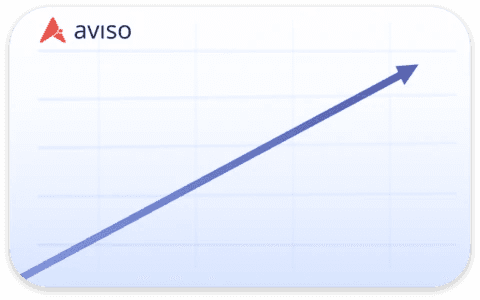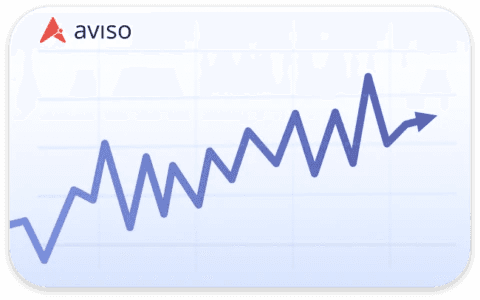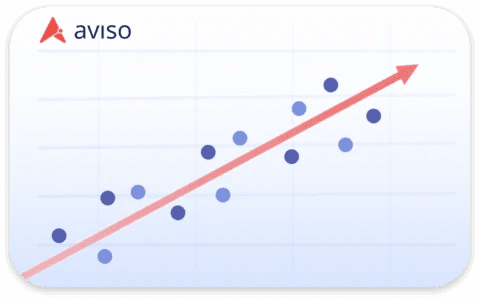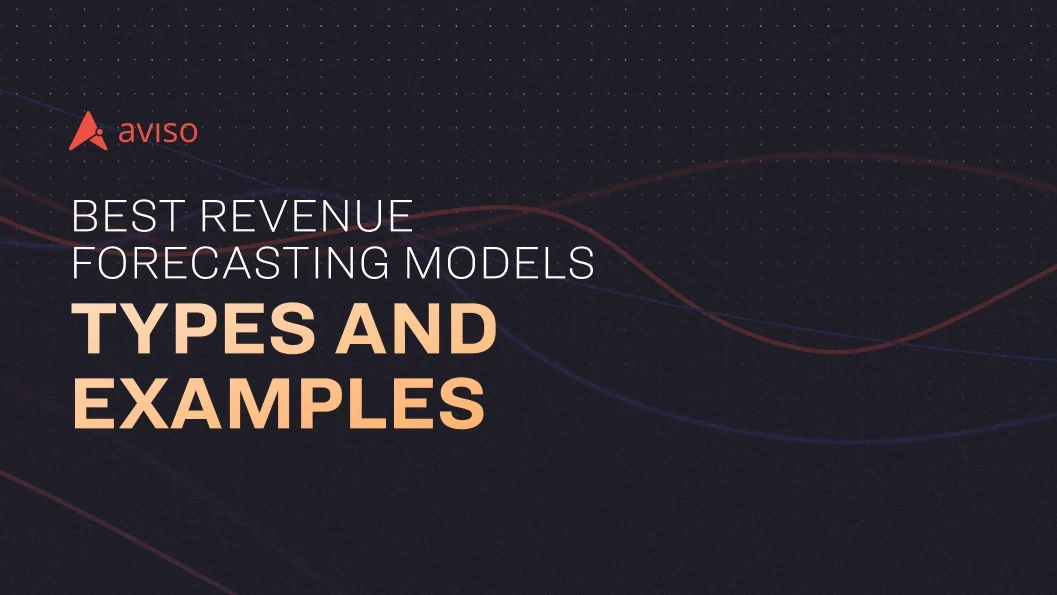Best Revenue Forecasting Models: Types And Examples
Aug 18, 2021
Most revenue and sales leaders spend a lot of time asking their team questions such as - are we achieving the revenue target this quarter? Or, should we increase our sales reps to meet goals? That's important because getting to know what will happen in future helps make informed decisions. Revenue forecasting helps resolve most of the questions. There are various revenue forecast methods that provide accurate projected revenues for upcoming months and quarters. These also provide insights that help you take necessary action towards constant growth. Here's what we'll cover in this article:
What is Revenue Forecasting?
Importance of Revenue Forecasting Models
4 Revenue Forecasting Models for Accurate Predictions
Revenue Forecasting Techniques
AI-Assisted Revenue Forecasting
Team Selling and Overlay Organizations
How Aviso Helps in Your Revenue Forecasting?
What Is Revenue Forecasting?
Let’s take a look at revenue forecasting, or the estimated projection of the amount generated by your overall business operations over a specific period of time. So, revenue forecasting is the process of computing the revenue of your business, either monthly, quarterly or annually. For example, if you want to know the revenue your business will generate in the next month, a forecasted revenue will tell you the estimated numbers. It is not a guesswork. Forecasting the revenue is based on the existing state of your business as well as your historical performance. A revenue forecast involves looking at your entire business, rather than only activities and quotas executed by your sales team. Compared to a sales forecasts, revenue forecasts tend to be more holistic.
Importance Of Revenue Forecasting Models
Forecast revenue is important for all businesses, as it helps strategize how quickly or how much you want to scale your business. However, it's also one of the most difficult things to estimate. Revenue forecasting models help us:View the future expansion of the business in terms of revenue and expenses.
Make critical decisions related to the staffing and revenue operations of the business.
Move beyond personal guesswork towards quantitative analysis to be more accurate.
Expand the business into new markets and set revenue goals for upcoming months.
4 Revenue Forecasting Models For Accurate Predictions
Revenue forecasting models (or methods) for accurate revenue predictions can either be quantitative or qualitative. Quantitative methods rely on measurable data, while qualitative methods rely on unmeasurable data. Also, revenue forecasting models aren't foolproof as they consider historical performance while showing the road ahead. But, if done properly, forecasting is mostly reliable. Let’s understand the methods with the help of revenue forecasting examples. Below we've explained four main types of revenue forecasting methods:
Straight Line Forecast Method:
This method requires only basic mathematics and hence very easy to put in place. It provides fair estimates of what to expect in your future financial growth. It considers your historical revenue growth rate to measure future growth.

Straight Line Forecasting Method For instance, if your business grew by 10 percent in the last 3 years, then using this method you can assume a similar growth rate in the next 2-3 years.
Moving Average Forecast Method:
A moving average calculates the average performance of a metric within shorter time periods, such as days, months, and quarters. It's not used for long time frames, such as years, as it develops too much lag. This method is mostly used to estimate revenues, sales growth, profits, and other similar financial metrics.

Moving Average Forecasting Method - This method is helpful to determine underlying patterns. A growing moving average shows an upward trend, while a declining moving average signifies a downward trend.
Time Series Forecast Method:
The time series method helps identify patterns in existing data that may repeat in the future. It focuses on data-driven forecasting across different financial metrics. This method is useful in scenarios where performance is mostly steady, and external trends affect forecasts.

Time Series Forecasting Method - For instance, this type of forecasting can use revenue growth from past months to update performance in the future months based on external trends.
Linear Regression Forecast Method
Linear regression depicts the relationship between two or more data points on a graph. It makes a trend line showing the relationship between the variables. This method is quite easy for businesses that create revenue forecasts in Excel. The trend line in this method helps forecast future growth, supports efficient budgeting, and helps in better decisions.

Linear Regression Forecasting Method-For instance, let's take sales and profits as two variables. If sales grow, then profits also increase, thus creating a linear regression depicting a positive correlation between the two variables. But if sales grow and profits reduce, it indicates challenges such as growing expenses.
Also Read: How To Accelerate Revenue Process?
Revenue Forecasting Techniques
Successful businesses have shown that forecast accuracy is enhanced by using certain revenue forecasting tips and techniques. Here are three fundamental techniques that can enhance your revenue forecasts.
Forecast for Each Product at the Right Level:
Most revenue forecasts consider the expected market growth rate along with current year sales. They also consider factors such as seasonality trends, number of products sold, and average selling price. But, some factors will always be more important than others, so they should be considered at a more granular level compared to others. For instance, the forecast of a fast-moving Product-A would always be different from that of a slow-moving Product-B.
Evaluate Sales Channel Productivity:
Revenue forecasts should always coordinate with your sales resources. Always check with your sales reps on how much they can achieve, and how fast they can convert leads into customers. Especially in B2B markets, sales quota planning is critical to forecast revenue. That's because factors such as the number of prospective customers in the pipeline and closing rates are important for revenue projections.
Cross Check Revenue Forecasts with Market Data:
Revenue leaders discuss a lot about how much revenue is required to cover all expenses while making significant profit. Such discussions should always be based on actual market data. Always do a top-down check of all revenue forecasts against the macro view of the market data. Most modern AI-assisted revenue forecasting tools take care of these tips and techniques for you. Below we’ll discuss what we mean by AI-assisted revenue predictions.
Revenue Forecast Formula
You can derive the forecasted revenue by multiplying your product's average selling price (for upcoming periods) with the expected number of product units sold. You can then make a decision to announce the forecasted revenue numbers during your investor conferences and financial meetings.
AI-Assisted Revenue Forecasting
Increasingly we are seeing companies wanting to have both a sales forecast and a revenue forecast. This is all nice to say, but the issue remains that more than 70% of all sales forecasts are wrong. To get around the problem of reps and managers not committing to early-stage deals, machine learning (ML) and predictive revenue analytics (part of Artificial Intelligence or AI) are increasingly being used as objective solutions to faulty forecasts. Using revenue forecasting AI software to “score” deals has been around for more than three years, so there has been time to assess the impact on customers and to judge what are the more appropriate use cases. There are two major components to predictive deal scoring:
Is this a good opportunity? — Is this a good fit based on product or solution, experience in this type of account or size of deal?
Will this close within the desired time range? — A measure of deal management. Going back to the different components of the forecast process, we can use that same list of component parts of the sales forecast, but this time, we can show where AI can be used to replace judgement-driven adjustments with adjustments based on data and the historical record. Here, AI helps transform your sales forecast into one that can apply to your company as a whole.
So the revenue forecast now looks like the following:Committed deals where reps are confident to close;
Judgement changes to forecast categories such as “commit”, “best case” or “worst case”;
Computation of amount adjustment based on historical variation depending on proximity to the projected close date;
Computation for “blue birds” — deals that are not currently in pipeline but will open and close within the quarter;
Yield calculation used to compute “cats and dogs”, smaller deals that are not managed at the deal level.
These numbers should also be broken out by product, support and services if the company in question has non-recurring revenue such as implementation services included in the opportunity amount.
Team Selling And Overlay Organizations
Team selling occurs where the opportunity amount is split by percentage across several or more individuals and may add to greater than 100%. Overlay organizations are those in which product specialists also own quota for their products or services within a larger opportunity. For example, for global sales accounts, there could be several salespersons working on the account (say, in North America and EMEA). The opportunity amount is shared between these reps with potentially the share or split being greater than 100%. For a sales forecast driven by quota attainment, the shared amount is applied up until there is a common management level, at which point the forecast amount needs to be adjusted down to reflect only 100% of the amount. In this instance, the sales forecast serves a different purpose than a revenue forecast would.
How Aviso Helps in Your Revenue Forecast?
Aviso’s approach to revenue forecasting is unique and comprehensive. Our platform is super flexible and scalable to configure any complex customer hierarchies. Our AI engine’s architecture not only predicts but also enables you to generate account and owner insights along with forecast explanations. Our revenue forecasting software helps derive accurate revenue forecasts for startups, small businesses, and large companies, as well as other unique businesses operating within different SaaS industries. Learn more about Aviso AI platform or contact us today to see how we can help you and your team achieve accurate revenue forecasts.







